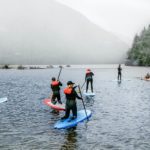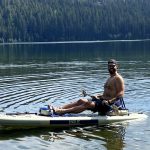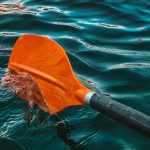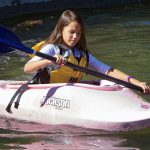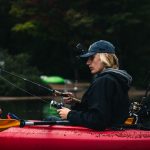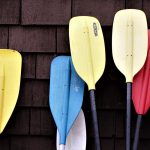Our guide to all types of paddle boards will help you understand which of many options will suit you best, based on material, design, size, and function.
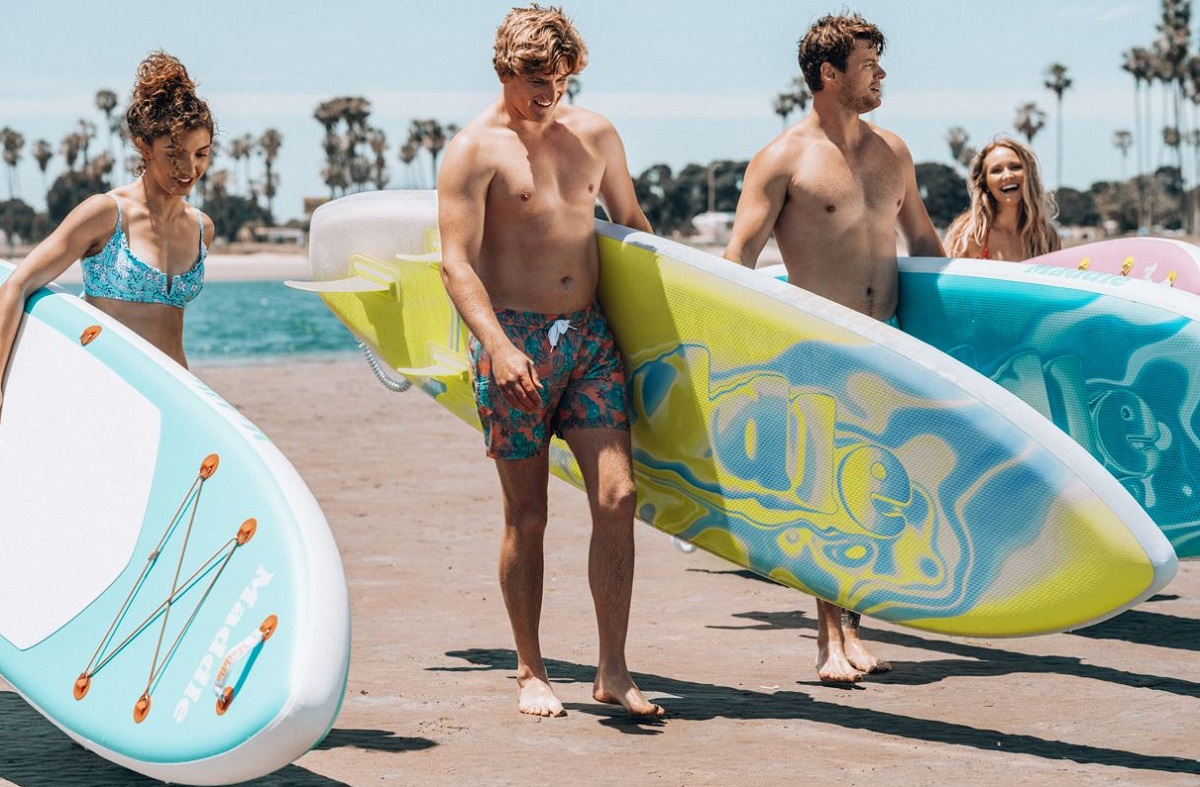
Summer is just around the corner, and you know what that means…
Paddleboarding season!
Paddleboarding is the perfect recreational activity for just about everyone–whatever your age or fitness level, you can find a form of paddleboarding that suits your tastes.
Just make sure you’ve got the right type of paddle board for you!
What does that mean, really, “the right type of paddleboard”? What makes a SUP board “wrong” or “right”?
That’s exactly what we’re going to find out in this article!
Below, we’re going to look at how to choose a paddle board based on all the crucial factors: type, size, hull, stability, speed, and more.
We’ll look at everything you need to know about selecting the right board for your specific activity, height and weight, even the size of your vehicle.
By the end of this post, you’ll be ready to choose the perfect stand-up paddle board for a truly spectacular summer.

Types of Paddle Boards
In order to choose the right SUP board, you’ve got to know the difference between the types of paddle boards.
Paddle boards are designed for specific activities, with slight variations on each design that make them better suited to one type of sport or use than any other type.
Knowing what you’re going to get up to will make it easier to choose the SUP board that suits your activity best.
Racing Board
As its name suggests, a racing paddle board is built exactly for that: SUP racing.
The design is all about speed. Typically, they’ll be longer, narrower boards designed with a displacement hull (see the explanation below) that slices through the water at higher speeds.
Racing boards do not have great maneuverability; they’re built to cover long distances straight forward at high speeds.

However, they’re designed to track as straight as possible, so you will waste less time and energy trying to stay on track and steer straight–all your effort will go into zipping forward.
Whitewater Board
A whitewater paddle board, as its name suggests, is built specifically for whitewater applications. That makes their two most important criteria:
- Durability. It’s gotta withstand bangs and bumps against rocks and survive the fast-paced, turbulent currents.
- Maneuverability. A whitewater paddle board is all about sharp turns at a moment’s notice to evade collisions and catch the currents just right.
It’s very rare to find inflatable paddle boards built for whitewater applications; they’ll usually be made out of ultra-tough materials with a hard shell (see the “Materials” section below).
They’ll also usually be shorter than your average recreational paddle board, with a planing hull and sleeker design that makes them capable of turning on a dime.
Recreational Board
Recreational paddle boards are all about stability on flat lakes, slow-moving rivers, and calm coastal waters. They’re the best beginner boards, and they tend to be fairly versatile all around. They’re also the most varied–you can find them in a wide range from an inflatable SUP board to a lightweight hard-shell design–as well as (typically) the most budget-friendly.

Yoga Board
A Yoga SUP board is built with the same general design as a recreational board (the planing hull) but is often a wider and longer board. This extra width and length provide excellent stability on calm, flat water, which is necessary to accommodate all those Yoga poses.
The wider board is less maneuverable, but given that you’re going to spend more time doing Yoga than paddling, that’s not at all a deal breaker.

Beginner paddlers will definitely find it easier to get their bearings and master the balance on a Yoga board, and they can graduate to more advanced styles of stand up paddle boarding later on.
Touring Boards
Most touring boards are built fairly similar to racing boards: they’re longer boards, not very wide, with a displacement hull perfect for slicing through the water. However, they’re also built with higher secondary stability in mind (see the “Stability” section below), which is necessary for keeping you stable when paddling through choppy oceans or riding waves.

Touring and racing boards usually have a similar paddle board shape, but the differences are just noticeable enough that you’ll want to get a board specifically for each activity.
Fishing Boards
Fishing boards are an angler’s best choice!
Fishing boards are built with a similar design to a Yoga stand-up paddle board: a longer, wider board that offers excellent primary stability, to serve as a platform from which to cast and reel in a line.
Fishing boards may not be quite as wide or long as a Yoga board, and they’re typically more maneuverable. They’re also great for a first paddle board for anyone who knows they’re eventually going to use it to fish once they master the paddle board basics.
Surf Paddle Boards
Surf SUP boards are built with agility in mind. They’re designed specifically to catch waves.
The board length may vary. Some will be a shorter and narrower board, similar in design to surf boards. Others will be a longer, wider board, similar in design to long boards.

But whatever the design, the surf SUP boards are built to handle the ocean’s swells and waves, and are built with a specific hull design and flexible rubber fins that make it easy to ride those waves.
(Fun Fact: Paddle boards were first created by the Hawaiian islanders not only to travel between islands but also to enjoy surfing.)
Kids’ Paddle Boards
If your child is interested in the sport, it may be a good idea to get them their own paddle board designed specifically for kids.
Kids’ paddle boards are usually short boards, with a sleeker design, and the board’s weight is typically low enough that your kids can carry it to and from your vehicle.
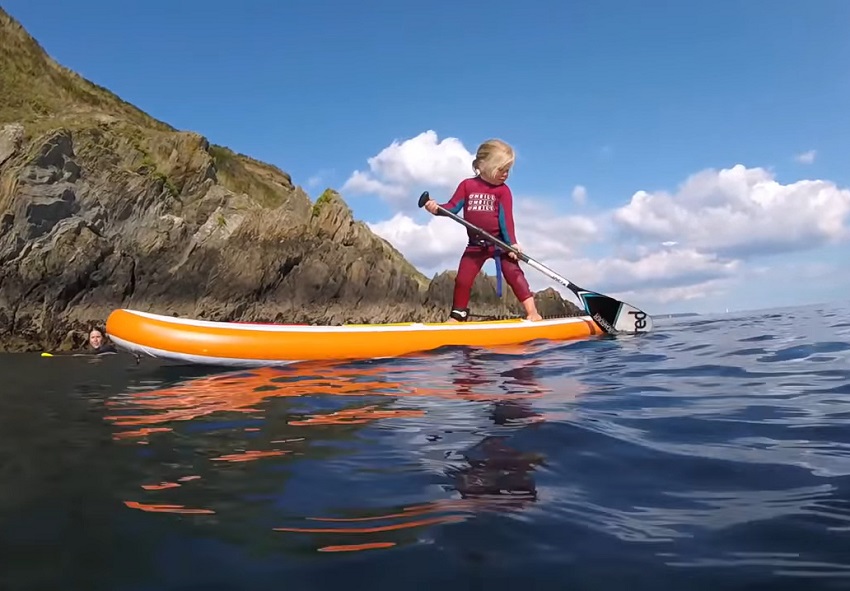
Most kids’ boards are designed for flatwater paddling; they have higher primary stability, better suited to enjoying a smooth ride on a calm lake or slow-moving river than wave riding.
Kids’ boards are inexpensive enough that they make a great first board, and can be the perfect solution to introduce your young ones to the paddle boarding sport.
What Size Paddle Board Do You Need?
When it comes to paddle board size, there are really two metrics that need to be discussed:
SUP Length

The length of your paddle board will directly affect its handling, tracking, speed, and agility.
Essentially, the longer the stand-up paddle board, the faster it will go, and the straighter it will track. In stark contrast, the shorter the SUP boards, the more agile they will be.
SUPs typically come in three lengths:
Under 10 Feet
Any board under 10 feet long will usually be built for one of three purposes:
- Surfing
- Whitewater paddle boarding
- Teaching kids how to paddle
The shorter board types won’t be quite as speedy, but they can handle sharp turns, ride waves, and are the most maneuverable of boards.
They’ll also usually feature a planing hull (see the “SUP Hull Types” section below to understand why this matters).
10-12 Feet
SUP boards between 10 and 12 feet in length are considered an “average size board”. They’re neither overly long nor overly short, which means they’re somewhere in the middle in terms of tracking, handling, speed, and maneuverability.
Typically, they’ll be built for one of three purposes:
- SUP Yoga
- Recreational use, and flat water paddling
- Fishing
Most paddleboards in this length range are fairly easy for beginners to use and offer good primary stability with some secondary stability (to handle currents and choppy water). They may have either a planing hull or a displacement hull, though they usually lean heavily toward the planning hull design.
Note: Most inflatable SUP boards also fall within this length range.
12+ Feet
Stand up paddle boards longer than 12 feet will usually be used for:
- Racing
- Touring, or long distance paddling
Their longer design and displacement hull make them the perfect paddle board to stay on course and slice through the water, even large wind waves. They are far from agile, but they’re capable of much greater speeds than a shorter board.
SUP Width
When it comes to SUP width, there’s a pretty simple rule of thumb: the wider the board, the higher its primary stability (on flat, calm water).
Most Yoga and recreational boards tend to be on the wider side because they’re designed with primary stability in mind.
By contrast, racing boards, touring boards, whitewater paddle boards, and surf paddle boards will be narrower because they need higher secondary stability.
Beginners will usually start off on a wider board, anywhere from 30 to 36 inches. Intermediate and expert paddlers will sometimes opt for narrower boards (25 to 30 inches) because they are experienced enough to exchange stability for speed or agility.
Regarding the SUP paddle board width, here are three rules of thumb to keep in mind:
- Match the board to body type. If you’re a shorter person, you may want a narrower board, because it’ll be easier to reach the water on either side of the board when paddling. Taller, heavier paddlers may want a wider board to accommodate their extra height and weight.
- Match the board to activity. Whitewater boards, surf paddle boards, racing boards, and touring boards are all on the narrower side. Fishing boards, recreational boards, and Yoga boards will all be wider and offer a more stable, smooth ride.
- Match the board to skill level. Beginners will likely find a wider stand-up paddle board best suited to their skill level, but the more you continue paddle boarding, the more options you’ve got. It may be worth sacrificing some width to gain speed or maneuverability as you get into more advanced types of paddle boarding.
SUP Hull Types
You can’t talk about the stand up paddle board types without getting into one of the most crucial elements: the hull.
After all, the hull design plays a huge role in the way the stand up paddle board handles and maneuvers, so that one detail could make the “right board” the “wrong board” if you choose the wrong hull.
There are two hull types:
Planing Hull
Planing hulls are designed for high primary stability (see the next section!). They feature a fairly flat underside and will usually be wider (above 30 inches).
This design (flat and wide) makes it right on top of the water, similar to how a surfboard rides. You’ll have greater maneuverability and stability on calm water, but won’t go quite as fast or have as much stability when stand up paddle boarding on chopper water.
The types of stand up paddle boards that use planing hulls are:
- SUP Yoga boards
- Recreational SUPs
- Fishing boards
- Whitewater rafting boards
- Surf paddle boards
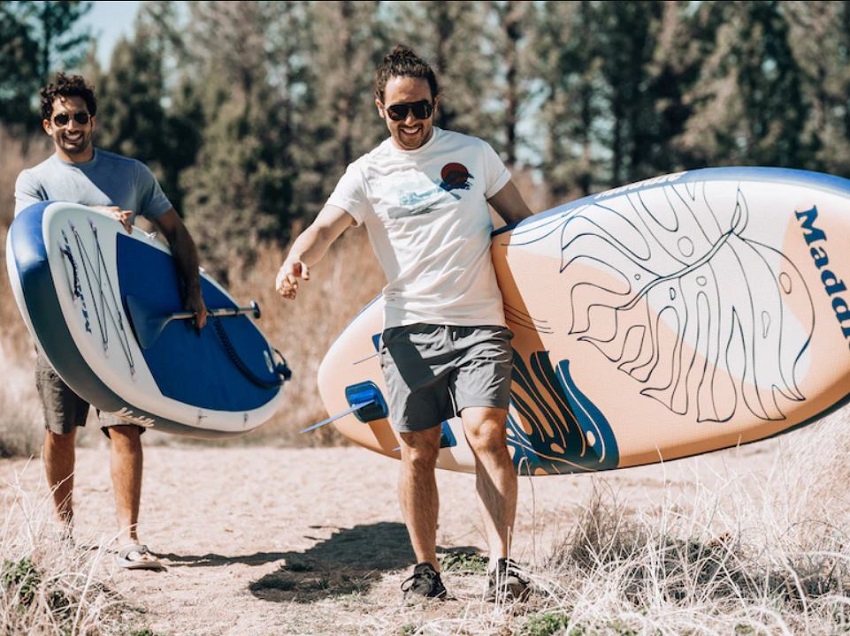
Displacement Hull
Displacement hulls feature a pointed nose and a shape that rides lower in the water (hence the “displacement” in its name) in order to A) slice through the water more efficiently, and B) track straighter.
Boards with displacement hulls will be ideal for racing, touring, and long-distance paddling because they stay on course, are less likely to be blown around by the wind, ride lower in the water, and are less agile and maneuverable than boards with a planing hull.
Paddleboard Stability

When we talk about the stability of the paddleboard, there are really two types of stability that need to be accounted for:
Primary stability, or stability on flat, calm water. These tend to be wider and longer boards, better suited to those with minimal paddle boarding experience or who want to enjoy a relaxing paddle.
Boards with high primary stability are typically used for:
- Fishing
- Recreational paddling
- SUP Yoga
- Racing
Secondary stability, or stability when the board is tipped over on its side (usually from high waves, choppy water, or whitewater rapids). Boards with high secondary stability may be a bit wobbly when on flat water, but they will handle rougher waters with ease.
Boards with high secondary stability are usually used for:
- SUP surfing
- Whitewater paddle boarding
- Touring
SUP Thickness
Board thickness matters because it directly contributes to not only your volume and weight capacity, but also agility and maneuverability.
A thinner board will be able to support less weight (both user weight and gear) but will typically be more agile. Many boards with displacement hulls will be on the thinner side.
A thicker board, on the other hand, can handle more weight, but will be less maneuverable and have significantly higher primary stability.
Volume and Weight Capacity
Volume and weight capacity typically go handle in hand, so we’ll talk about them together.
Both the volume and weight capacity are determined by the board’s width, thickness, and length. Essentially, the longer, thicker, and wider the board, the higher the volume and weight capacity it has.
Volume refers to the board’s ability to properly float when loaded with your body weight and the weight of your gear. The volume is expressed in liters, a number that may not make a lot of sense to newbies, but which is a critical metric to advanced paddlers who understand that even minute changes can affect how a board performs.
Weight Capacity refers to how much weight a board can handle–not just you, the paddler, but also your gear (coolers, tackle boxes, sleeping bag, tent, etc.). The weight capacity is expressed in pounds or kilograms, a number that even newbies can easily understand.
Both volume and weight capacity matter because they tell you how heavy a paddler (and their gear) can be in order to use the board.
For smaller paddlers (compact adults, teenagers, and children), most paddle boards will more than suffice to accommodate their weight. However, for bigger, heavier paddlers (like myself, at 6’6″ and 250 lbs.), volume and weight capacity become very important metrics to consider.
Paddleboard Speed
Speed may not be a big deal if you’re planning on spending a relaxing day out on the lake, paddling down a slow-moving river, fishing, doing SUP Yoga, or enjoying the beach.
However, for racing and long-distance paddling, speed becomes a very critical factor to consider.
Just remember: longer, narrower boards tend to be much faster than boards that are shorter and wider. A displacement hull will also make a board significantly speedier than a flat planing hull.
SUP Maneuverability
Maneuverability is most important for certain types of paddle boarding, chiefly SUP surfing and whitewater paddling. The shorter and narrower the paddle board, the more maneuverable it will be.
Solid vs. Inflatable Board
Inflatable paddle boards have become ultra-popular in the last few years, and they offer a few “pros” that solid paddle boards may not. Both have their advantages and drawbacks that are worth mentioning:
Solid Boards

Pros:
- More durable, better for whitewater paddling and any type of paddle boarding where your board might sustain damage.
- More rigidity, which means a more solid surface and better shape retention–making them better for racing, touring, and surf paddle boards.
- Easier to craft into a displacement hull, which is why they’re typically used for racing and touring boards.
Cons:
- Unable to deflate/fold down small, so less portable than inflatable boards
- Less buoyancy, so harder for new paddlers to master
Inflatable Boards
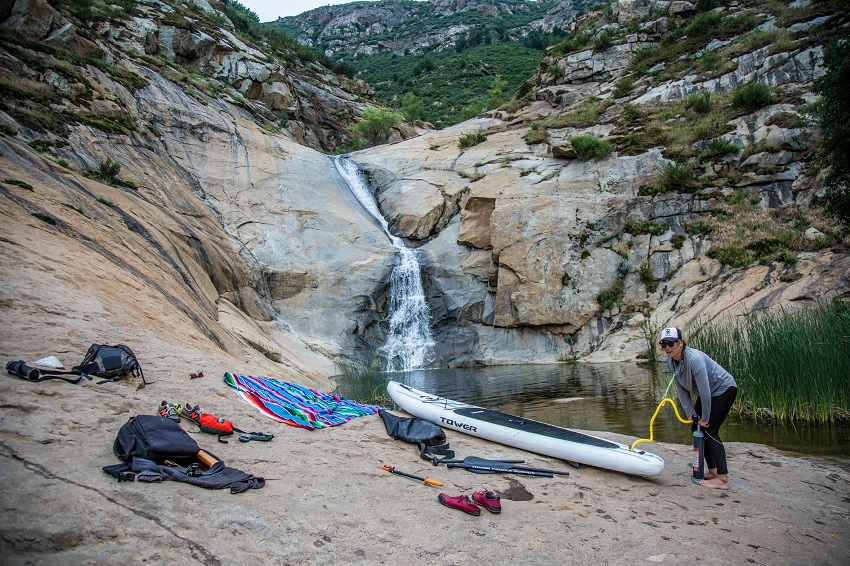
Pros:
- Can be deflated and folded down small (roughly the size of a suitcase), and thus are eminently more portable than hard boards.
- Better buoyancy and primary stability. An inflatable board is filled with air and thus floats atop the water. Better-suited to calm, flat water.
- Typically more affordable (materials used are cheaper).
Cons:
- Not as durable as hard boards. Less suitable for whitewater or surfing paddling.
- Don’t track as well (even with flexible rubber fins attached) and will never be as speedy. Typically only feature a planing hull.
Both hard and soft boards are worth considering; which you choose will depend largely on what your intended activity will be.
SUP Materials

I could write an entire article around the materials used to create stand up paddleboards–and, in fact, I did, called “Types of Paddle Boards: A Complete Guide to SUPs of All Shapes and Sizes“.
In that article, I take a deep dive into each material type, looking at the pros, cons, and applications of each. If you want a lot more information, I highly recommend you go check out that article.
For the sake of brevity in this article, though, I’ll keep it short and give you just the basics on each of the standard SUP materials so you have a better idea which will suit your needs best:
Plastic
Plastic paddle boards are typically made using either polyethylene, or a mix of PVC and polycarbonates.
Polyethylene is used in rotomolded and thermoformed hard-shell kayaks, and it’s a very tough material that’s budget-friendly. You’ll find many whitewater paddle boards are made using PE.
The mixture of PVC and polycarbonate results in a very tough but flexible plastic that is pricier than PE, but lasts longer. Higher-end whitewater paddle boards are often made using this PVC/PC mixture, as are higher-end racing and touring kayaks.

Epoxy
An epoxy board is made with a special epoxy resin, usually wrapped around an EPS foam core. When left to harden, epoxy resin is very tough, capable of withstanding a great deal of stress, impact, and tension. No surprise, then, that many whitewater paddle boards are epoxy boards, as are higher-end racing and touring boards.
Epoxy boards that feature an EPS foam core will also be significantly lighter than plastic boards. Both epoxy and EPS foam weigh notably less than plastic, so the end-result is a board up to 25% lighter.
EPS Foam
Some boards are made entirely out of EPS foam–not just the core, but the whole board. Typically, the EPS foam will be reinforced (using a metal or plastic piece called a “stringer” that runs through the core) in order to create a stable, sturdy platform to stand on.
EPS foam is very lightweight and buoyant, but not the most durable material.
Wood
Wood is the OG, the material that was first used by the Hawaiian islanders to craft their long-distance and surf paddle boards.
Hawaiians used Koa tree wood (which is a dense, oil-rich wood highly resistant to water), but modern wooden SUPs can use paulownia, pine, bamboo, and white cedar.
Wooden boards tend to have a hollow frame, which means a lighter weight, greater buoyancy, and higher primary stability. However, they’re not as durable as synthetic materials.

Composite
Composite SUPs are made using either:
- Fiberglass, which is ultra-lightweight, ideal for racing and touring boards. It’s not the most durable, though, so won’t be utilized for whitewater boards. It’s also pricey, so expect to pay top dollar.
- Carbon fiber, which is said to be “tougher than steel”. It’s lightweight but also on the expensive side, typically used only in the highest-end paddle boards. Because of its durability, it’s perfect for top-quality whitewater paddle boards.
Inflatable
The average inflatable SUP will be made using some combination of PVC and polycarbonate, which is durable enough for recreational use (SUP Yoga, flat water paddling, fishing, perhaps even surfing).
Modern drop-stitching technology has made these boards even tougher and more resilient, so your average inflatable SUP has a lifespan roughly on par with a hard-shell recreational paddle board.
Paddle Board Deck
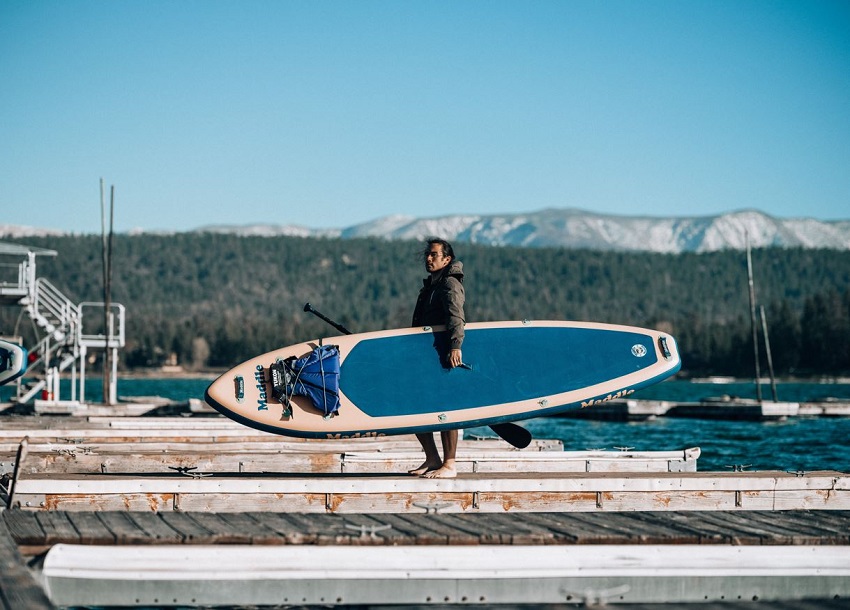
There are three basic deck types:
- Soft foam deck. With this type, a soft foam deck pad (or multiple deck pads) will be integrated into the board’s deck. A foam deck pad will provide cushioning for your feet as you stand or knees as you kneel, and can make the paddling experience more comfortable.
- Rubber deck. A rubber deck pad is designed to offer you good traction when the board or your feet are wet. Typically, surf, whitewater, and fishing SUPs will feature a rubber deck.
- Hard deck. Sometimes, it’s better not to have anything between you (the paddler) and the deck in order to provide maximum traction and control. Some racing, touring, and kids SUPs will use no deck pad at all, so you are sitting, standing, or kneeling directly on the board itself.
SUP Skegs/Fins
Fins and skegs are added to SUPs to not only improve steering and tracking, but also add stability.
This is especially important on boards with a planing hull–having a fin deep in the water will create drag and prevent the board from tipping over.
There are a few ways that fins can be added onto a paddle board:
- Single center fin. Some boards will feature a single fin, typically located in the center of the board’s width and located near the rear of the board’s length. This placement allows for not only greater stability, but also better speed. Sliding the fin forward (if the design allows for it) will increase agility and help you make faster, sharper turns, but at a cost of stability.
- Three fins. Having three fins side by side on the back of your board is ideal for surf paddleboarding, as well as flatwater paddling. They improve your control over the board. Typically, racing and touring boards will have this fin placement.
- 2+1 configuration. This placement (a single center fin with two shorter fins, called skegs, on either side) is common for SUPs that want better control but don’t want to sacrifice agility.
Fins come in many shapes and sizes, as well as a wide range of materials.
For example, race fins will often be made using carbon fiber or fiberglass. Inflatable paddle boards may feature detachable semi-rigid fins made out of rubber or soft plastic.
However, for the average newbie, you can start off with the fins that came provided with the SUP, and that’ll be enough for the time being. You can always upgrade the fins or alter the fin placement as your skills advance.
SUP Accessories
Many SUPs come with nothing but the board, which means you have to spend extra on accessories like:
- Paddle
- Seat
- Additional deck webbing
- Ankle strap
- Seat
- Pump (for inflatable SUPs)
These accessories are nice to have, but it’s not a dealbreaker if the paddle board doesn’t come with them.
Price: How Much is a SUP Board?
The higher-end the paddleboard (based on materials used), the pricier it will be.
Typically, you can find a budget paddle board starting at around $200 (for cheaper hardshell), and rising as high as $600 or so. An inflatable paddle board may start at $400, and rise as high as $800 while still being a “budget” board.
When you want to get into the mid-tier and higher-end range of paddle boards (such as racing boards, touring boards, or whitewater boards), you’re looking at upwards of $1,000, with the really pricey ones running you easily $2,000+.
Your average inflatable paddle board, however, is very unlikely to cost more than $1,800 even at the highest end.
Stand Up Paddleboard FAQs
A single fin is standard for most SUPs, but if you want greater speed and straighter tracking to cover long distances, you may want to upgrade to add two more fins–or, at the very least, two skegs to accompany your center fin.
The weight of a paddle board matters to YOU, the one who has to carry it to and from the water, load and unload it from your car. When on the water, though, the only weight that matters is the board’s “weight capacity”–how much paddler and gear it can handle while still remaining afloat.
The beauty of paddle boarding is that anyone can do it. It will require a bit of core and leg strength to maintain your balance on the board, but that strength is easily developed with a bit of time and practice.
Sure, more advanced types of paddleboarding (such as whitewater paddling, racing, or touring) will require more fitness. But for recreational paddling or fishing, you can get started even if you’ve never lifted a weight or run a mile in your life.
Make sure the blade of your paddle is planted fully and firmly in the water as you begin your paddling stroke.
Stand in the proper position: knees slightly bent, back straight, and head up.
Let your core muscles do a lot of the paddling work, as that keeps your arms from tiring out too quickly.
Keep your board quiet and under control for more efficient paddling.

